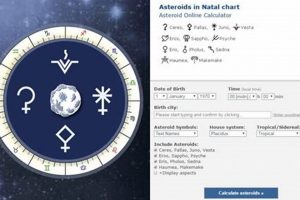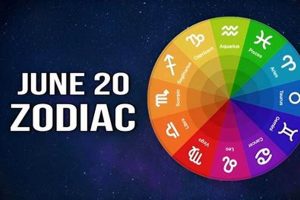In astrology, the stylized glyph representing Juno, often depicted as a scepter topped with a star, signifies commitment, marriage, partnerships, and the balance of power within relationships. This celestial body’s placement within a natal chart offers astrologers insights into an individual’s approach to long-term unions, highlighting potential strengths and challenges related to cooperation, compromise, and shared responsibilities.
Understanding this archetypes influence can provide valuable self-awareness regarding relationship dynamics and patterns. Its placement can illuminate areas where an individual seeks equality and fairness, as well as potential sensitivities surrounding dominance and control. Historically linked to the Roman goddess of marriage and childbirth, this astrological influence emphasizes the importance of mutual respect and shared values in creating lasting, fulfilling bonds. Examining this placement contributes to a deeper understanding of relationship needs and preferences.
Further exploration of this astrological element can include an examination of its aspects to other planets, its position in a particular astrological house, and how its energy manifests across different zodiac signs. These nuances provide a more comprehensive understanding of its role in shaping individual relationship experiences and potential for growth.
Tips for Understanding Committed Partnerships Through Astrological Analysis
These tips provide guidance for interpreting the influence of a specific astrological archetype related to committed partnerships.
Tip 1: Chart Placement: Note the astrological sign and house placement within the natal chart. The sign indicates how one expresses commitment, while the house reveals the area of life where these themes are most prominent.
Tip 2: Aspects: Analyze planetary aspects. Harmonious aspects suggest ease in forming and maintaining partnerships, while challenging aspects might indicate areas requiring greater attention and compromise.
Tip 3: Synastry: Compare charts with partners to understand relationship dynamics. Overlapping placements can highlight areas of synergy and potential conflict.
Tip 4: Transit Analysis: Observe transits to this astrological point to gain insights into current relationship themes and potential turning points.
Tip 5: Self-Reflection: Consider how these astrological insights resonate with personal experiences. Self-awareness fosters growth and positive relationship development.
Tip 6: Professional Guidance: Consulting with an experienced astrologer can provide personalized interpretations and practical advice.
By understanding these factors, individuals can gain valuable insights into their approach to commitment and build stronger, more fulfilling relationships.
These insights provide a foundation for fostering greater understanding and navigating the complexities of long-term partnerships.
1. Commitment
Commitment, a cornerstone of Juno’s astrological significance, represents the desire for enduring, meaningful partnerships. Juno’s placement within a natal chart illuminates an individual’s approach to commitment, revealing potential strengths and challenges in establishing and maintaining long-term relationships. A prominent Juno placement might signify a deep yearning for connection and a willingness to invest time and effort in building lasting bonds. Conversely, challenging aspects to Juno might suggest difficulties with commitment, perhaps stemming from fear of vulnerability or past relationship traumas. Consider, for instance, a hypothetical individual with Juno conjunct Saturn. This placement could indicate a serious and cautious approach to commitment, potentially leading to delayed or carefully considered partnerships. Alternatively, Juno in Sagittarius might suggest a desire for a partner who shares a love of exploration and intellectual freedom, emphasizing the importance of shared values within the commitment.
Understanding the role of commitment within the context of Juno’s influence allows for a deeper appreciation of relationship dynamics. It offers insights into an individual’s capacity for loyalty, devotion, and the willingness to work through challenges. For example, someone with Juno in Libra might prioritize harmony and balance within their relationships, seeking commitment built on mutual respect and fairness. Analyzing aspects to Juno provides further nuance. Harmonious aspects, such as a trine to Venus, might suggest ease in forming committed partnerships. Conversely, challenging aspects, such as a square to Uranus, could indicate a tendency toward fluctuating commitment levels or a need for independence within the relationship. These astrological insights provide a framework for understanding relationship patterns and offer potential pathways for growth and deeper connection.
In summary, commitment serves as a defining characteristic of Juno’s astrological influence. Examining Juno’s placement and aspects within a natal chart offers valuable self-awareness and a deeper understanding of one’s approach to long-term relationships. This knowledge can empower individuals to navigate relationship challenges more effectively, fostering stronger, more fulfilling partnerships based on mutual understanding and shared values. Further exploration of other relevant astrological placements can provide a more comprehensive understanding of individual relationship dynamics.
2. Marriage
Within the framework of astrological interpretation, Juno’s association with marriage extends beyond the legal contract, encompassing the deeper energetic dynamics of committed partnership. It symbolizes the merging of two individuals into a shared life path, highlighting the importance of mutual respect, shared responsibilities, and the ongoing negotiation of power dynamics. Juno’s placement in a natal chart can offer insights into an individual’s conscious and unconscious expectations surrounding marriage, including their ideal partnership model and potential challenges in achieving marital harmony. For example, a natal Juno in Aries might suggest a desire for a marriage characterized by passion and independence, while Juno in Cancer might indicate a need for emotional security and a nurturing home environment. Individuals with challenging aspects to Juno, such as a square to Pluto, might encounter power struggles or transformative experiences within their marriages.
While societal views on marriage have evolved, Juno’s astrological significance remains relevant, offering a lens through which to understand the complex interplay of individual needs and shared goals within long-term partnerships. Examining synastry, the comparison of two individuals’ astrological charts, can illuminate potential areas of compatibility and conflict within a marriage. For instance, if one partner’s Juno forms a harmonious aspect to the other partner’s Sun, this could indicate a strong sense of mutual support and admiration. Conversely, challenging aspects between Juno and planets like Saturn or Uranus might suggest difficulties with commitment or a need for greater individual freedom within the marriage. Consider a hypothetical couple where one partner has Juno in Virgo and the other has Juno in Pisces. The Virgo placement might prioritize practicality and order within the marriage, while the Pisces placement might emphasize emotional connection and fluidity. Navigating these differing approaches requires understanding and compromise from both partners.
In summary, Juno’s connection to marriage offers valuable insights into the underlying dynamics of committed partnerships. By understanding Juno’s placement and aspects within a natal chart, individuals can gain greater self-awareness regarding their marital expectations and potential challenges. Synastry provides further understanding of relationship dynamics within a marriage, highlighting areas of strength and potential conflict. These astrological insights can facilitate more conscious and fulfilling partnerships built on mutual respect, shared values, and a willingness to navigate the complexities of long-term commitment. Further exploration of other relevant astrological placements can provide a more holistic understanding of individual relationship patterns.
3. Partnerships
Within astrological analysis, Juno’s influence extends beyond marriage to encompass the broader spectrum of partnerships. This celestial body’s placement within a natal chart illuminates an individual’s approach to all forms of committed relationships, offering insights into their collaboration style, negotiation tactics, and the dynamics they seek or attract in partnerships. Understanding Juno’s role in partnership dynamics provides a framework for navigating various relationship types, from romantic entanglements to business collaborations and platonic bonds. Its influence highlights core values surrounding fairness, equality, and the balance of power within any form of committed union.
- Power Dynamics
Juno’s placement can reveal an individual’s comfort level with power dynamics within partnerships. Some placements might indicate a preference for equal footing and shared decision-making, while others might suggest a tendency towards either asserting dominance or yielding to a partner’s influence. For example, Juno in Leo might indicate a desire for recognition and a degree of control within partnerships, while Juno in Pisces could suggest a greater willingness to accommodate a partner’s needs. Examining aspects to Juno further clarifies these tendencies. A challenging aspect to Pluto, for instance, could signify power struggles or a need for transformative experiences within partnerships.
- Compromise and Negotiation
Juno’s influence sheds light on an individual’s approach to compromise and negotiation within partnerships. Some placements might signify a natural ability to find common ground and navigate disagreements diplomatically, while others might indicate a tendency towards inflexibility or avoidance of conflict. Juno in Libra, for example, might suggest a preference for harmonious resolutions and a willingness to compromise, whereas Juno in Capricorn could indicate a more pragmatic approach to negotiation, prioritizing long-term stability over immediate gratification. Examining aspects to Mercury can provide additional insights into communication styles within partnerships.
- Shared Values and Goals
Juno’s placement highlights the importance of shared values and goals within partnerships. It can reveal the types of connections an individual seeks, whether based on shared intellectual pursuits, emotional intimacy, or practical considerations. For instance, Juno in Aquarius might indicate a preference for partnerships built on intellectual stimulation and shared humanitarian ideals, while Juno in Taurus might suggest a desire for stability, security, and shared material resources. Examining Juno’s aspects to Jupiter and Saturn can offer further understanding of the individual’s approach to expansion and commitment within partnerships. Synastry comparisons can reveal the degree of alignment in values and goals between partners, providing insights into the long-term potential of the relationship.
- Long-Term Sustainability
Juno’s placement offers insights into an individual’s capacity for creating sustainable, long-term partnerships. Some placements might suggest a natural inclination towards commitment and longevity, while others might indicate a tendency towards fluctuating commitment levels or a need for greater independence. Juno in Scorpio, for example, could signify intense loyalty and a desire for deep, transformative partnerships, while Juno in Gemini might suggest a preference for adaptable and intellectually stimulating connections. Analyzing Juno’s aspects to outer planets like Uranus and Neptune can provide further insight into the potential for longevity and stability within partnerships.
By examining these facets of Juno’s influence, individuals gain a deeper understanding of their own partnership dynamics and the underlying patterns that shape their interactions with others. This astrological perspective offers valuable self-awareness, enabling individuals to navigate relationship challenges more effectively and foster stronger, more fulfilling partnerships based on mutual respect, open communication, and shared values. Further exploration of other relevant astrological placements, combined with an understanding of personal experiences, provides a comprehensive understanding of relationship patterns and their potential for growth.
4. Balance of Power
In astrological interpretations, the concept of “balance of power” holds significant weight, particularly concerning Juno, the asteroid associated with committed partnerships. Juno’s placement in a natal chart illuminates an individual’s approach to power dynamics within relationships, highlighting potential challenges and opportunities for growth. This exploration delves into the multifaceted nature of power balance within the context of Juno’s influence, offering insights into how individuals navigate issues of equality, control, and shared responsibility within their partnerships.
- Negotiation and Decision-Making
Juno’s influence sheds light on an individual’s preferred negotiation style and approach to decision-making within partnerships. Certain placements might suggest a predisposition towards collaborative decision-making, valuing equal input from all parties. Other placements might indicate a tendency towards assuming a leadership role or deferring to a partner’s judgment. For example, Juno in Libra often seeks diplomatic solutions and balanced compromises, whereas Juno in Capricorn might prioritize practical considerations and long-term stability in decision-making processes. Analyzing aspects to Mercury and Saturn can provide further nuances regarding communication styles and the influence of responsibility within these dynamics.
- Sharing of Responsibilities
Juno’s placement can reveal an individual’s approach to the division of labor and shared responsibilities within partnerships. Some placements might indicate a preference for clearly defined roles and responsibilities, while others might suggest a more fluid and adaptable approach. Juno in Virgo, for instance, often emphasizes practicality and efficiency in task allocation, whereas Juno in Pisces might prioritize emotional support and intuitive understanding of needs. Examining aspects to Mars and the Moon can provide additional insights into how individuals assert their needs and navigate emotional dynamics related to shared responsibilities.
- Control and Autonomy
Juno’s influence highlights the tension between individual autonomy and shared control within partnerships. Certain placements might suggest a strong need for independence and personal space, while others might indicate a preference for merging resources and sharing control more readily. Juno in Aquarius, for example, often values individual freedom and intellectual autonomy within partnerships, whereas Juno in Scorpio might seek deep emotional merging and shared control over resources. Analyzing aspects to Uranus and Pluto can offer deeper insights into the individual’s relationship with control and their capacity for transformation within partnerships.
- Equality and Fairness
Juno’s placement illuminates an individual’s understanding of equality and fairness within the context of committed partnerships. Some placements might prioritize equitable distribution of resources and opportunities, while others might emphasize emotional reciprocity and mutual respect as key components of fairness. Juno in Gemini often seeks intellectual equality and open communication, whereas Juno in Cancer might prioritize emotional security and nurturing within the partnership dynamic. Aspects to Venus and Jupiter can provide further nuances regarding values related to love, abundance, and fairness within partnerships.
Understanding these facets of power balance within the context of Juno’s influence provides valuable insights into relationship dynamics. By examining Juno’s placement, aspects, and its interplay with other astrological factors, individuals gain a deeper understanding of their own needs and expectations within partnerships. This awareness can facilitate more conscious and fulfilling relationships built on mutual respect, open communication, and a balanced distribution of power. Further exploration of synastry, the comparison of two natal charts, can illuminate potential areas of synergy and conflict related to power dynamics within specific relationships.
Within the framework of astrological interpretation, shared values represent a cornerstone of Juno’s influence, signifying the importance of aligned principles and mutual understanding within committed partnerships. Juno’s placement in a natal chart illuminates an individual’s core values and how these values influence relationship dynamics. This exploration delves into the multifaceted nature of shared values within the context of Juno’s influence, offering insights into how these values contribute to long-term relationship satisfaction and stability.
- Moral and Ethical Alignment
Juno’s placement can reveal the types of moral and ethical principles an individual prioritizes in partnerships. Strong Juno aspects to Jupiter or Saturn, for example, might emphasize a need for partners who share a strong moral compass and demonstrate integrity. Conversely, challenging aspects to Neptune might indicate a tendency to overlook or rationalize differing values, potentially leading to conflict later in the relationship. Consider a hypothetical scenario where one partner has Juno conjunct Saturn and the other has Juno conjunct Neptune. The Saturn-influenced individual might prioritize responsibility and commitment, while the Neptune-influenced individual might emphasize empathy and compassion. Navigating these differing approaches requires open communication and a willingness to understand each other’s perspectives.
- Lifestyle Compatibility
Juno’s influence extends to lifestyle preferences, highlighting the importance of compatible lifestyle choices within partnerships. Juno in Taurus, for instance, might suggest a desire for stability and a shared appreciation for material comforts, whereas Juno in Sagittarius could indicate a need for a partner who shares a love of travel and exploration. Mismatched lifestyles can lead to tension and conflict. For example, a partner with Juno in Capricorn might prioritize career advancement and financial security, while a partner with Juno in Aquarius might value community involvement and social activism. Finding common ground and negotiating priorities is crucial for long-term harmony.
- Intellectual and Spiritual Connection
Juno’s placement can reveal the importance of intellectual and spiritual connection within partnerships. Juno in Gemini, for example, might signify a need for a partner who stimulates intellectual curiosity and engages in meaningful conversations. Juno in Pisces might suggest a desire for a partner who shares spiritual beliefs and engages in introspective practices. A lack of intellectual or spiritual connection can lead to feelings of isolation or disengagement within the partnership. For instance, if one partner prioritizes intellectual pursuits while the other focuses primarily on emotional connection, finding ways to bridge this gap is crucial for mutual understanding and fulfillment.
- Long-Term Goals and Visions
Juno’s placement can illuminate an individual’s long-term goals and visions for their partnerships. Juno in Cancer, for example, might indicate a desire for a family-oriented partnership centered around emotional security and nurturing. Juno in Capricorn might suggest a focus on building a stable and successful future together, prioritizing career advancement and financial security. Conflicting long-term visions can create significant challenges within a partnership. For instance, if one partner envisions a life rooted in one location while the other dreams of frequent travel and relocation, navigating these differing aspirations requires open communication and a willingness to compromise.
Understanding the role of shared values within the context of Juno’s influence provides a framework for building stronger, more fulfilling partnerships. By recognizing the significance of aligned principles, compatible lifestyles, and shared visions, individuals can navigate relationship challenges more effectively and cultivate deeper connections based on mutual understanding and respect. Further exploration of synastry, the comparison of two natal charts, can illuminate the degree of value alignment between partners, offering insights into the long-term potential of the relationship. Additionally, analyzing aspects to other planets and asteroids can provide a more nuanced understanding of individual values and their influence on partnership dynamics.
Frequently Asked Questions about Juno in Astrology
This section addresses common inquiries regarding the astrological significance of Juno, offering concise and informative responses.
Question 1: How does Juno differ from Venus in astrological interpretation, considering both relate to relationships?
While Venus represents attraction and the experience of romance, Juno signifies commitment, the legal bonds of partnership, and the dynamics of long-term relationships. Venus highlights initial attraction and romantic expression, whereas Juno governs the sustained effort and negotiation required for lasting commitment.
Question 2: Is Juno’s influence relevant only in romantic relationships?
Juno’s influence extends to all forms of committed partnerships, including business collaborations, close friendships, and family relationships. It highlights the dynamics of power, compromise, and shared responsibility within any committed union.
Question 3: How does one determine Juno’s placement in their natal chart?
Juno’s placement requires astrological chart calculation based on birth date, time, and location. Numerous online resources and astrological software programs can generate natal charts, indicating Juno’s sign and house placement.
Question 4: What does a challenging aspect to Juno in a natal chart signify?
Challenging aspects, such as squares or oppositions to Juno, may indicate potential difficulties or recurring patterns within committed partnerships. These aspects do not signify predetermined outcomes, but rather highlight areas requiring attention and conscious effort for growth and resolution. Professional consultation with an experienced astrologer can provide further insights into navigating these challenges effectively.
Question 5: How does Juno’s placement interact with other astrological placements in a natal chart?
Juno’s placement interacts with other astrological placements to create a complex tapestry of influences. For example, Juno’s aspects to personal planets like Venus and Mars can offer insight into relationship dynamics, while aspects to outer planets like Saturn and Uranus might influence commitment patterns and the need for freedom within partnerships. A holistic chart analysis considers the interplay of all placements for a comprehensive understanding.
Question 6: Can Juno’s influence change over time?
While Juno’s natal placement remains constant, its expression can evolve through personal growth and conscious awareness. Transits, the movement of celestial bodies, also influence Juno’s expression over time, creating periods of heightened focus on relationship dynamics or opportunities for transformation within partnerships. Ongoing self-reflection and an openness to growth can facilitate a deeper understanding and more conscious navigation of Juno’s influence.
Understanding Juno’s astrological influence offers valuable insights into the complexities of committed partnerships. Further research and consultation with experienced astrologers can provide more personalized guidance.
For further exploration of related concepts, the following section examines the symbolic representations associated with Juno in greater detail.
Juno Symbol Astrology
This exploration of Juno’s astrological significance has illuminated its multifaceted influence on committed partnerships, highlighting the importance of shared values, balance of power, and the ongoing negotiation inherent in long-term relationships. From navigating the complexities of marriage to understanding the dynamics of various partnership types, Juno’s placement within a natal chart offers valuable insights into individual needs, expectations, and potential challenges within committed unions. Its symbolism provides a framework for understanding how individuals approach commitment, compromise, and the pursuit of lasting connection.
Ultimately, understanding Juno’s influence empowers individuals to navigate the intricate landscape of relationships with greater awareness and intention. This knowledge fosters not only a deeper understanding of oneself but also a greater capacity for building stronger, more fulfilling partnerships based on mutual respect, open communication, and a conscious commitment to shared growth. Further exploration of related astrological principles offers continued opportunities for self-discovery and relationship enrichment.







